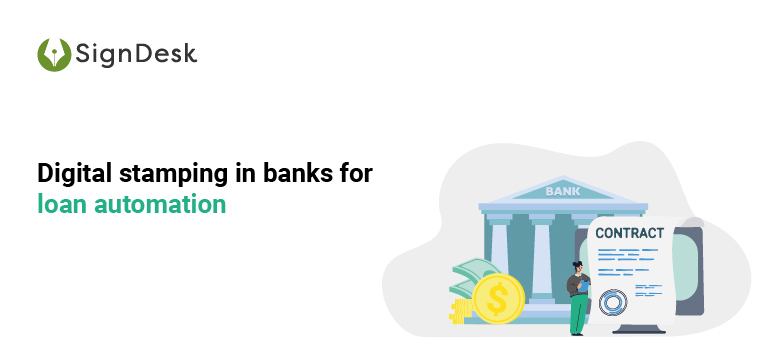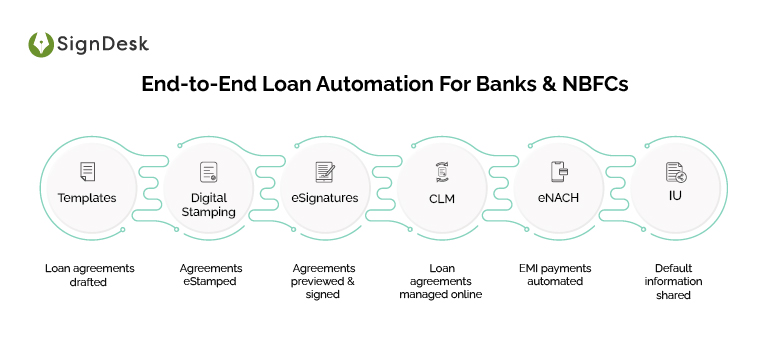
Digital Stamping in Banks: What Is It?
To legitimize documents, digital stamping or online stamping is a technique that involves the safe payment of stamp duty online, often known as e-stamping. Customers are unclear about the legality of digital stamping in banks and other sectors, which is a substitute for physical stamping because the method is still relatively new.
The stamping process is simplified with the help of online stamping as it removes the need to purchase stamp sheets from suppliers manually. By adopting the digital stamping method, an organization further diminishes document storage errors, storage costs, and timely results as there’s no poor documentation management.
Stamp duty for stamp paper for loans and other purposes is a fee levied by state governments on the acquisition of legal documents and the legalization of agreements. These contracts are often used to deal with agreements and transfers of certain instruments such as assets or capital between parties. The Indian Stamp Act of 1899 governs all stamp duties and legal stamp paper in India which are further codified by specific state stamping statutes.
Digital Stamping provides a secure computerized means of stamping papers and stops government income from getting leaked. It also allows information to be stored in a secure format, electronically and establishes a central data bank for quick authentication.
Appearing on a digitally stamped document, an e stamp acts as confirmation of stamp duty payment as well as assurance that a document or other item of information delivered digitally came from the entity that submitted it.
The Role of Stamping & Stamp Paper in Loan Disbursal
Stamp papers are indispensable for business and loan units in banks. As executives know, most loan documentation needs to be stamped in order to be legalized, and for the loan disbursal to proceed without any friction.
Loan agreements need to be drawn on stamp paper as they are agreements involving commercial transactions between the borrower and the bank. Due to this requirement of stamping for loans, banks are highly dependent on the easy availability of stamp papers.
Physical or manual stamping (franking), in most cases, is responsible for a number of hindrances to the loan disbursal workflows of banks. This is because the process of getting large numbers of loan agreements manually stamped is both tedious and time-consuming.
Solving Challenges in Loan Disbursal for Banks & NBFCs
Business teams need to manually order large reams of stamp paper, a process plagued by supply issues, following which loan agreements must be printed on these stamp papers and notarized. This entire process takes several days and results in financial institutions overpaying for a process that should be simpler and easier to complete.
With digital stamping, banks can streamline and expedite the stamp duty payment process. E-stamp papers reduce the turnaround time for loan agreement stamping by over 70%, from days to mere minutes.
Due to the digital nature of the E-Stamping process, banks can also scale up loan disbursal by getting documents digitally stamped in bulk.
Banks can use digital stamping to give their clients legitimate digital stamp papers for activities such as loan applications. Additionally, digital stamps on documents can provide banks with a secure document collecting and retrieval system.
The stamp duty for loan disbursal also varies from state to state, further complicating the stamping process. Stamp duty depends on the stamp act of that particular state which allows to levy stamp duty when one applies for a loan.
Digital stamping solutions offer a neat workaround for this problem by having pre-coded stamp duty rates and in-built stamp duty calculators which auto-fill the stamp duty charges to be paid for any state.
Digital stamping, therefore, plays a major role in making loan disbursements faster and more efficient for both banks and borrowers. Loan automation using digital stamping is quickly becoming the benchmark for banks.
Digital Stamping for Loan Automation
Through APIs, mobile, or desktop portals, the digital stamping in banks for documents may be seamlessly connected with a bank’s operations encompassing loan disbursement, account opening, and so on. The following describes the end-to-end procedure of a bank disbursing a loan to a client using eStamp integration.
The steps for digital stamping in banks for a document are as follows:
- Log into the SignDesk digital stamping portal.
- Fill in the relevant information (stamp state, party names, stamp denominations, etc) in the bank form template.
- Key stamp details get auto-filled as per customizations and requirements.
- Enter the Aadhaar Number to generate a One Time Password (OTP) in the registered mobile number.
- The form submitted is eStamped and eSigned as soon as the OTP gets verified.
- Pay stamp duty using a convenient digital wallet.
- The document is eStamped in seconds.
- Customers and banks can now download the final eStamped form.
Where manual stamping takes a lot of time to get completed and requires utmost care, digital stamping makes the process get over within a handful amount of time. Digital stamping also helps secure loan documents and eases the loan documentation cycle for banks and NBFCs.
By incorporating this digital stamping workflow into their loan disbursement process, banks can upscale and boost their loan rates. Further, technologies such as digital stamping and eSignatures enable banks and NBFCs to automate loan disbursement from end to end.
Here’s what a completely automated loan disbursement process looks like when banks employ a document automation suite.
- Loan documents drafted using custom templates
- Loan documents digitally stamped
- Borrower invited to view and sign
- Borrower and bank executives eSign loan agreement
- Loan agreements are stored & managed online for easy reference
- Loan EMI payments automated using eNACH eMandate
- IU integrations for insolvency information and to inform banks of default
End to End Loan Automation For Banks & NBFCs

Advantages of Digital Stamping in Banks for Digitized Loan Automation
As mentioned above, there are certain advantages when one opts for digital stamping in banks. The benefits of getting digital stamp duty for digitized loan automation are as follows:
- Faster and Efficient Loan Disbursement:
The process of loan disbursement becomes easier and faster with digital stamps as it reduces the hassle of running for the generation and payment of stamp duty. The process that usually takes days to complete, manually, gets over in minutes with online digital stamping.
- Expandability:
Banks and other financial institutions swiftly extend their operations by automating financial activities with eStamping. Digital stamping adds to the variety of banking procedures, which includes fast account opening, loan documentation execution, and helping banks generate more loans.
- Cost and Time Effective:
Many businesses also enjoy large cost savings since they spend little or no money on ink, paper, or printing. Other indirect expenses, such as filing, archiving, or tracking, are also reduced.
- Uniqueness:
An estamp certificate comes with its own Unique Identification Number (UIN) and a QR code which makes it easy to identify and lessens the chances of getting it tampered with.
- Improved Customer Experience:
With digital stamping, the banks provide the users the opportunity to choose any stamp denomination, state, or instrument type as per their choice for online stamping. The bank can also provide customers with downloadable eStamped loan agreements according to their convenience.
Stamp.It: SignDesk’s One Stop Solution for Digital Stamping
Stamp.It by SignDesk is a nationally acclaimed digital and online stamping system with eSign integrations. Businesses in finance can leverage Stamp.it, India’s leading digital stamping technology, to cut loan agreement stamping cycles from days to minutes.
Stamp.It offers a number of features and benefits for borrowers and loan executives:
- Organizational templates can be digitized on a large scale.
- Stamp duty payment simplification
- Bulk signings for vendor and distributor agreements on the go
- Remote contract execution
- Developing rapid-fire documentation processes
- The use of digital stamping and an eSign workflow solution simplifies contract and agreement documentation for numerous industrial segments.
With Stamp.It, business teams can now implement loan automation with digital stamping in banks in minutes. Book a free on-demand demo now to see how it works.